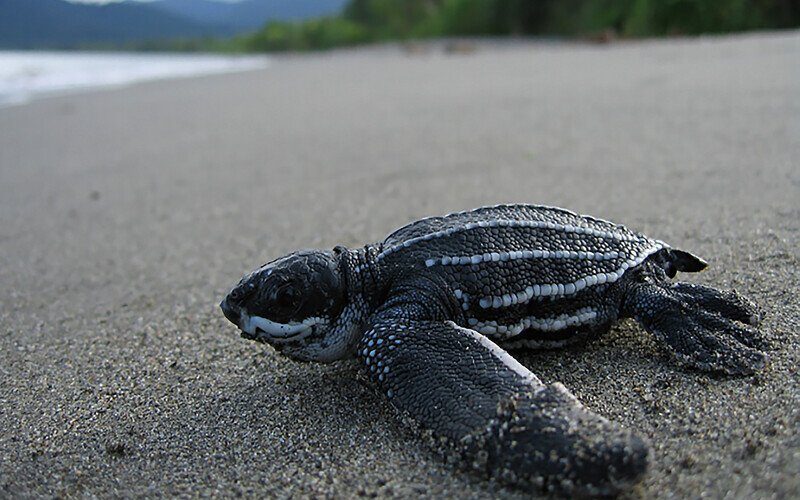SAN JUAN — Conservation groups filed a legal petition today urging the U.S. Fish and Wildlife Service to revise protected critical habitat for the leatherback sea turtle (Dermochelys coriacea) under the Endangered Species Act.
The petition asks the wildlife agency to protect three important leatherback nesting beaches in Puerto Rico and to consider the addition of other important nesting beaches for this species on the island.
Amigos de las Tortugas Marinas, Vida Marina Center for Conservation and Ecological Restoration, Yo Amo el Tinglar and the Center for Biological Diversity submitted the petition.
“The trend of the leatherback turtle population in the Northwest Atlantic demonstrates an accelerated decline. It is imperative to increase the protection that the species receives,” said Luis Crespo, president of Amigos de las Tortugas Marinas and Puerto Rico WIDECAST country coordinator. “Playa California in Maunabo is one of the main leatherback nesting beaches in Puerto Rico and one of the few places where the population cohort shows signs of recovery.”
“Our group monitors and protects sea turtles on the northwestern and western coasts of the main island of Puerto Rico, including Tres Hermanos Beach in Añasco, and we are witnessing all the threats that these animals face in this area,” said Robert Mayer, Ph.D., director of Vida Marina Center for Conservation and Ecological Restoration at the University of Puerto Rico. “We definitely need this added level of protection for sea turtles in Puerto Rico.”
“Playa Grande in Arecibo is among the most important nesting beaches for leatherbacks in Puerto Rico,” said Myrna Concepcion, project leader from Comité Arecibeño por la Conservacion de las Tortugas Marinas, known as “Yo Amo el Tinglar.” “A critical habitat designation would provide further protection for this beach, which is in constant threat of development.”
“In Puerto Rico, beaches are heavily used for urban development and recreation, presenting a serious threat to the survival of the endangered leatherback turtle,” said Carlos E. Diez, Sea Turtle Project coordinator at the Puerto Rico Department of Natural and Environmental Resources and member of the IUCN Sea Turtle Specialist Group. “Therefore, a federal critical habitat designation to enhance the protection and recovery of this species is needed. We hope the federal government acts quickly to approve this important designation.”
“Puerto Rico represents an important stronghold of nesting activity for leatherbacks in the Caribbean and the Northwest Atlantic sub-population,” said Jessica Castro, Ph.D., Caribbean conservation coordinator at the National Wildlife Refuge Association, a contributor to the petition. “Increasing the legal protection of key nesting beaches within U.S and its territories is an important contribution for the conservation of a highly migratory and endangered species.”
“The Endangered Species Act’s strong critical habitat protections are needed to safeguard these important leatherback nesting beaches,” said Elise Bennett, Florida and Caribbean director and attorney at the Center for Biological Diversity. “Beaches like these are critical to the future of these wonderful, ancient creatures, so we need federal action.”
Leatherback sea turtles are the largest turtles in the world and existed at the same time as dinosaurs. They are highly migratory, travelling thousands of miles a year, and they can dive to great depths — nearly 4,000 feet.
Leatherbacks have been federally protected as endangered since 1970. They are threatened by fishing gear bycatch, direct harvest, habitat destruction, ocean pollution, vessel strikes and climate change. A recent federal review of leatherback sea turtle science concluded that all seven distinct populations of leatherback sea turtles worldwide remain endangered.
Today’s petition asks the U.S. Fish and Wildlife Service to protect three leatherback nesting beaches in Puerto Rico: California Beach, Maunabo; Tres Hermanos Beach, Añasco; and Grande Beach, Arecibo.
The leatherback sea turtle currently has terrestrial critical habitat only on a stretch of beach at Sandy Point, St. Croix, in the U.S. Virgin Islands, and marine critical habitat in waters off Sandy Point in the North Atlantic Ocean, and off the coasts of California, Oregon and Washington in the Pacific Ocean.
Puerto Rico, Florida and the U.S. Virgin Islands host the most important nesting beaches for leatherback sea turtles under U.S. jurisdiction.
Species with federally protected critical habitat are more than twice as likely to recover as species without it. The Endangered Species Act prohibits federal agencies from authorizing activities that would destroy or harm a listed species’ critical habitat.
SOURCE: Center for Biological Diversity
Leatherback sea turtle main photo courtesy of: NOAA Fisheries

